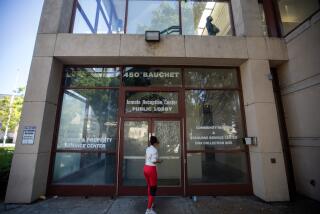37 Blame Illness on Fumes in Workplace
Nearly a third of the employees in a subdistrict headquarters for the Los Angeles city schools have filed workers’ compensation claims because of repeated exposure to solvent fumes from an adjacent print shop.
Los Angeles Unified School District officials are awaiting results of tests to determine how badly the 37 workers were exposed at the Boyle Avenue building on the Eastside.
A workers’ compensation doctor who examined the employees observed symptoms consistent with a solvent exposure in most of them, said Angelo Bellomo, director of the district’s Office of Environmental Health and Safety.
The solvent was not identified.
The symptoms included respiratory problems such as dry cough and lightheadedness, Bellomo said.
Lab tests, however, did not show levels that would be expected to have long-term effects on health.
The workers’ compensation filings streamed in about the same time the district’s internal auditors warned that workers’ compensation costs are rising dramatically because of poor attention to injury prevention, fragmented tracking of cases and poor internal communications.
Inspector General Don Mullinax said in the April 22 report that the district’s annual losses had climbed steadily through the 1990s, hitting $100 million in 1999-2000.
The chemical exposure also illustrates how difficult it is for the district to find suitable space in Los Angeles--for administrative functions as well as schools.
The Subdistrict H office is at the back of a Verizon Information Services industrial complex and shares a building with a print shop that produces the Yellow Pages.
Workers’ complaints began almost immediately after the district office opened in October 2000.
Since then, Verizon has made modifications to the air-conditioning system that seemed to lessen the odors.
District inspectors took air samples at the site several times.
However, they detected no solvent traces that would trigger intervention from environmental health regulators, Bellomo said.
Last month, however, the odors became unbearable for some workers when the air-conditioning system malfunctioned.
“It was very noticeable as soon as you walk in the door,” said Luz Cotto, a coordinator in the district’s secondary literacy program.
Cotto said she had an allergic reaction that made her sneeze and cough, gave her a headache and caused a burning sensation in her throat.
She went home.
“I had to leave,” she said.
Another worker, Robert Drake, said he wasn’t bothered and continued to work.
But Bellomo, who came to the site in person after a worker called the South Coast Air Quality Management District, said he was “shocked at how bad the problem was.”
The district then convened an all-hands meeting.
Officials provided workers’ compensation forms and offered the employees consultations with a doctor.
Of the 37 workers who filed claims, only one has been given the OK to return to work, Subdistrict H Supt. Bonnie Rubio said Monday.
Twelve others remain home on the doctor’s orders and five have returned to work against the doctor’s advice.
Nineteen are on field assignments outside the building.
Verizon officials referred questions to its corporate communications office in Dallas.
Spokeswoman DeAnna Kriege said that the company works hard to maintain a clean shop.
She said that it has easily passed inspections by the South Coast Air Quality Management District and the California Division of Occupational Health and Safety.
A March inspection by the division found that the concentrations of regulated chemicals in the area where Verizon workers use solvents to clean the presses were only about half the maximum levels allowed, Kriege said.
However, Bellomo said, inspectors from his office who visited the site over the last two years had failed to take into account the subjective nature of human chemical reactions.
Many people could be bothered or even injured by low-level exposure to chemicals that others can tolerate and that would meet the regulatory standard for an industrial setting, Bellomo said
Just the fact that so many people reacted, Bellomo said, “is highly suggestive it does not provide the kind of environment that office workers expect, unless they work for a print shop.”
Dr. Ashokkumar L. Jain, a USC occupational toxicologist, said solvent exposures can have immediate effects from forgetfulness and irritability to long-term health troubles including balance problems and cancer.
The reactions depend on the types of chemicals and amount of exposure.
Jain said he has seen circumstances in which workers outside a plant had higher exposures than those actually working with the chemicals because the exhaust system was moving the vapors in their direction.
Bellomo said he expects to give employees the results of the toxicological tests later this week.
In the meantime, he is still considering whether he will recommend moving the headquarters.
“I think I’m close to that decision, but I’m not there yet,” he said.
The odors, even if not at a toxicological level, are unacceptable, he said.
Rubio said she has worked with Verizon to try to solve the problem rather than recommend a move elsewhere because she believes that most employees want to stay put.
“I think they want to stay here,” Rubio said.
“This is a good location,” she said. “We are near our schools. We feel it serves our purpose. “
The location provides plenty of parking and floor space, which is tough to find in the crowded area.
More to Read
Sign up for Essential California
The most important California stories and recommendations in your inbox every morning.
You may occasionally receive promotional content from the Los Angeles Times.











